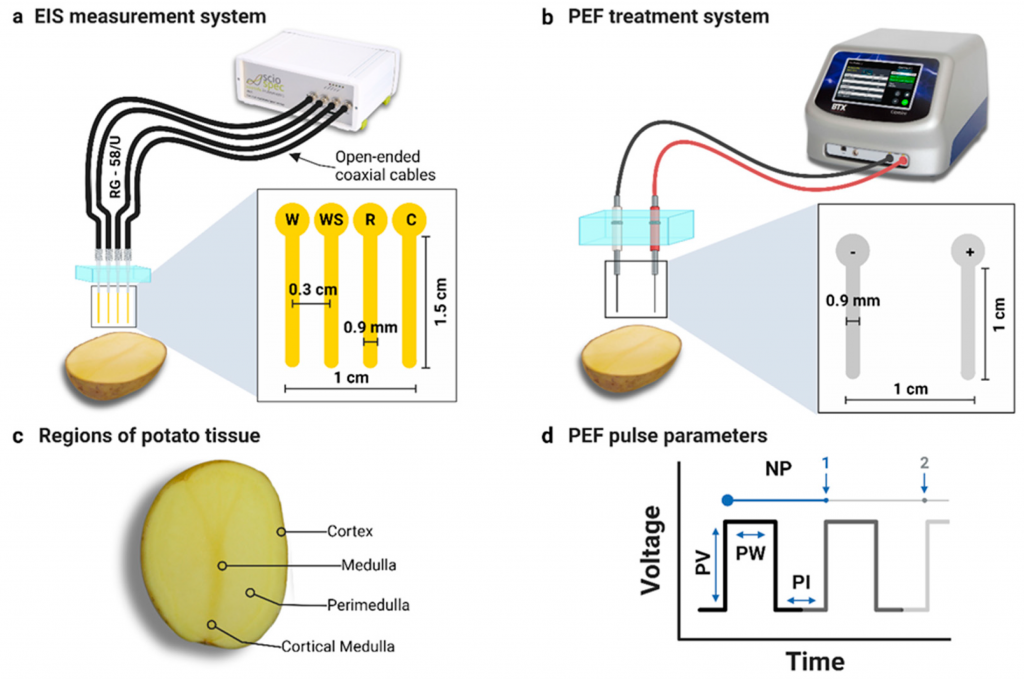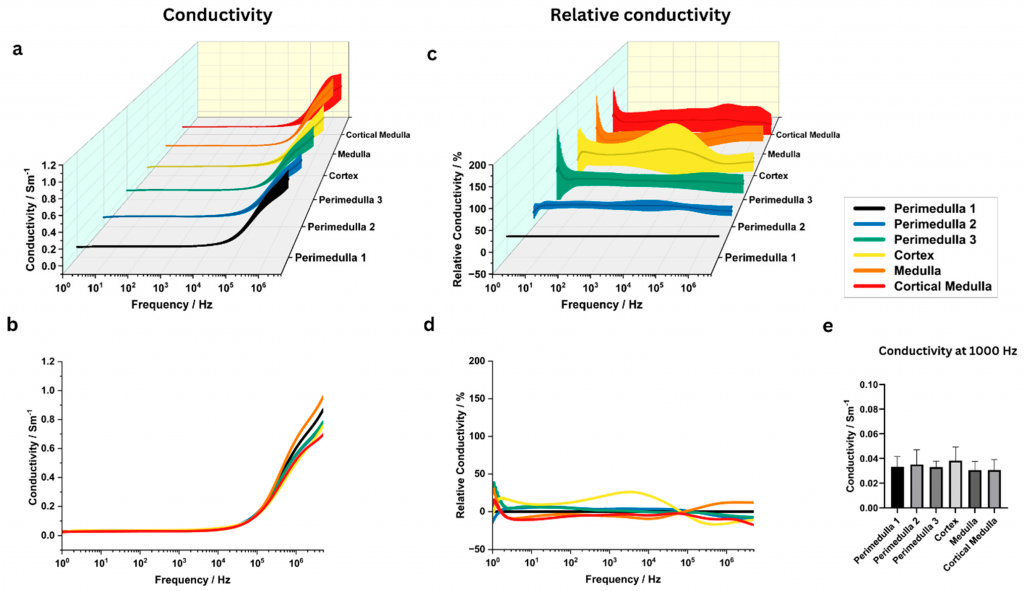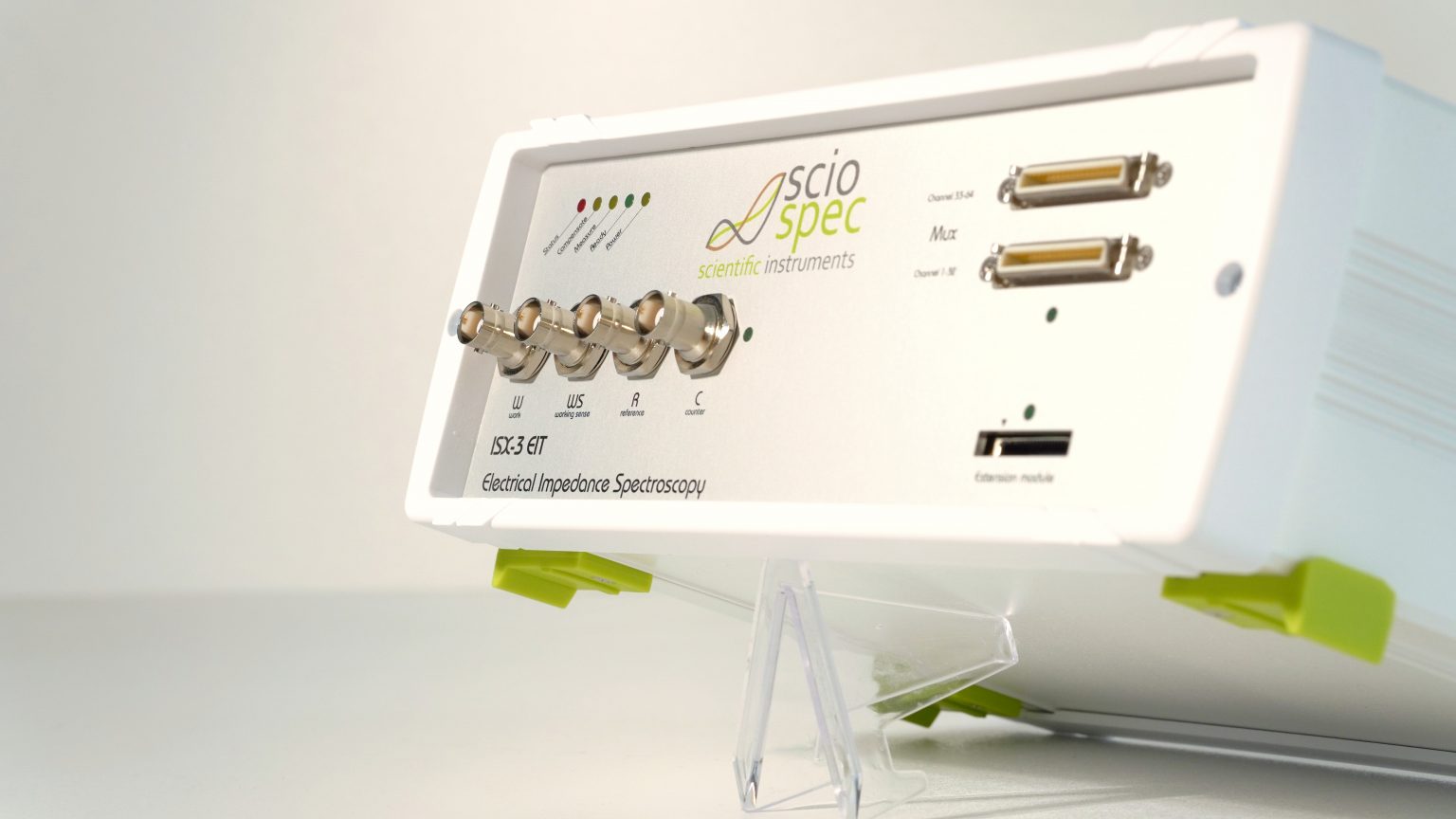

The recent study titled “Influence of Pulsed Electric Field Parameters on Electrical Conductivity in Solanum tuberosum Measured by Electrochemical Impedance Spectroscopy” (Applied Sciences, 2025) investigates how pulsed electric fields (PEFs) affect tissue conductivity, a foundational concept in electroporation research.
By applying various PEF parameters to potato tissue and evaluating conductivity across a wide frequency spectrum using electrochemical impedance spectroscopy (EIS), the researchers aim to provide data useful for developing electroporation protocols and conductivity-based imaging techniques.This article explores how the Sciospec ISX‑3 Impedance Analyzer enables such measurements, and how its precise signal acquisition supports safer, non-animal-based electroporation models.
*Thomas, A., Lemainque, T., Baragona, M., Pfeffer, J.-G., & Ritter, A. Influence of Pulsed Electric Field Parameters on Electrical Conductivity in Solanum tuberosum Measured by Electrochemical Impedance Spectroscopy. Applied Sciences (2024). https://www.mdpi.com/2076-3417/15/14/7922
Electroporation techniques like irreversible electroporation (IRE) are gaining ground in medicine for procedures such as tissue ablation. But before these methods can be safely applied, researchers need reliable ways to measure how electric pulses affect tissue especially in the early stages.
In this study, the team used potato tissue as a simplified model to test how different pulse settings such as voltage, number of pulses, and timing change how the tissue conducts electricity. To capture these changes accurately, they used the Sciospec ISX‑3, which allowed them to measure how the tissue responded across a wide frequency range.
Thanks to the ISX‑3’s sensitive and flexible measurements, the researchers were able to pinpoint a key frequency (1000 Hz) where the difference between treated and untreated areas was most visible. This kind of insight is useful for improving electroporation that rely on tracking conductivity inside tissues.
Want to know how electric pulses affect biological samples? Contact Our Experts to see how the ISX‑3 helps researchers with for early electroporation monitoring


Potato tissue was selected in this study as a plant-based alternative to animal models for electroporation research. Its uniform cellular structure and predictable electrical characteristics make it ideal for early-stage parameter testing.
Researchers found that untreated samples exhibited stable impedance profiles, while regions treated with pulsed electric fields showed clear increases in conductivity, indicating membrane permeabilization. The Sciospec ISX‑3 enabled high-resolution impedance measurements across test conditions, supporting fast, reproducible, and non-invasive assessment of tissue analogs.
Planning Ethical electroporation assays ? See how the ISX‑3 supports precision impedance screening in plant-based models.
To capture the subtle shifts in tissue conductivity across the frequency spectrum, a high-resolution impedance system is essential. Although the publication used a custom-built EIS probe, its functionality aligns closely with what the Sciospec ISX‑3 delivers in a modular, ready-to-integrate platform.
Key capabilities that support this type of research include:
👉Need versatility in conductivity measurements? Discover the ISX‑3’s multi-electrode, multi-frequency capabilities


Studies like this one require testing a wide range of pulsed electric field (PEF) settings: changing voltage, pulse width, number of pulses, and intervals. To efficiently collect meaningful data across all these conditions, researchers benefit from tools that can handle multiple samples or repeated runs without manual reconfiguration.
The Sciospec ISX‑3 platform supports automated channel routing through multiplexer modules that allow up to 32 or 64 measurement channels. This enables automatic switching between electrodes or test sites, helping researchers conduct systematic experiments like those in this study.
Planning large-scale PEF studies ? See how the ISX‑3 multiplexing accelerates data collection across samples
From EIS to EIT: ISX 3EIT for Conductivity Imaging
While this study focused on measuring conductivity changes in potato tissue, its findings support broader efforts to visualize such changes especially in techniques like Electrical Impedance Tomography (EIT), where conductivity mapping plays a central role. For researchers interested in imaging the effects of pulsed electric fields, Sciospec offers the ISX‑3EIT, an advanced solution built for scalable, high-resolution impedance imaging.
The ISX‑3EIT expands on the capabilities of the standard ISX‑3 by enabling:
This makes the ISX‑3EIT ideal for translating conductivity insights into imaging applications in medicine, agriculture, and industrial process monitoring.
Looking to evolve from measurement to imaging? Discover the ISX‑3EIT for conductivity-based visualization.


Our experts are ready to help you understanding how this technology works and how you can apply and integrate it into your work. Get in touch today to get a personalized consultation to enhance your work with our advanced solutions
Pulsed electric field (PEF) treatment involves applying short bursts of high-voltage electrical energy to biological tissues to alter cell membranes. It’s commonly used in irreversible electroporation (IRE), food processing, and biomedical research. In electroporation, PEF can cause pores to form in cell membranes temporarily or permanently depending on the pulse intensity and duration. This study used PEF to explore how different electrical parameters impact tissue conductivity, measured using electrochemical impedance spectroscopy (EIS) with the Sciospec ISX‑3 platform.
Potato tissue (Solanum tuberosum) is often used as a model system in electroporation studies because of its consistency, accessibility, and structural similarity to soft biological tissues. It allows researchers to test electrical parameters safely without using animal models. In this study, potato samples helped researchers observe conductivity changes under different PEF settings, with the ISX‑3 capturing detailed frequency-based measurements across treated and untreated regions.
Irreversible electroporation (IRE) is a medical technique where strong electric pulses cause permanent damage to cell membranes, leading to cell death. It’s being explored for non-thermal tissue ablation in cancer treatments and other clinical uses. This research supports IRE modeling by identifying how tissue conductivity shifts at specific PEF parameters and frequencies. Using the ISX‑3, the study identified 1000 Hz as a key frequency for distinguishing treated regions data that could inform future IRE protocol development.
The study found that 1000 Hz provided the strongest contrast between untreated and PEF-treated tissue regions. At this frequency, the changes in conductivity caused by electroporation were most clearly visible, making it ideal for assessing treatment effects. Thanks to the frequency resolution and flexibility of the Sciospec ISX‑3, researchers were able to scan a broad range (1 Hz to 5 MHz) and pinpoint where conductivity differences were most pronounced.
EIS measures how electrical signals move through tissues, revealing changes in structure, hydration, or cell integrity. In PEF studies, it’s used to detect how electric pulses alter these properties without damaging or altering the sample further. In this research, EIS helped quantify the impact of different PEF settings on tissue conductivity in a precise, non-invasive way. The ISX‑3 platform supported this by offering stable, high-resolution readings across all tested parameters.
This study confirms that electrochemical impedance spectroscopy (EIS) can effectively track conductivity changes in tissue exposed to pulsed electric fields using a simple plant model. With the Sciospec ISX‑3, researchers captured frequency-dependent responses tied to electroporation conditions, helping to refine protocols without invasive testing.
The ISX‑3’s measurement precision and scalability make it a strong tool for advancing electroporation studies and material-based bioelectric research.
Exploring electrical changes in biological systems ? Talk to us to see how the ISX‑3 can bring clarity and confidence to your EIS workflow.
See also:
“The effects of temperature on electrical impedance of biological tissues”
💡Curious for more? Check out our latest developments and products.
🧪Want to try it yourself? Contact us for more information
🚀Looking for a tailored solution? Our experts can help!
📢 Follow us on LinkedIn for more updates.
#Innovation #Sciospec #pulsedelectricfields #irreversibleelectroporation #Plant-BasedElectroporation
explore by relevant keywords
…or just browse our most recent posts: